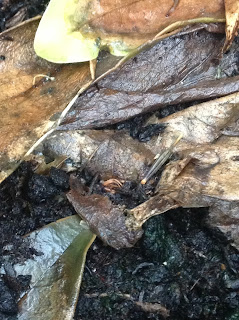The artist I
am mainly focusing on is Mexican artist Frida Kahlo. Kahlo was born in
Coyoacan, Mexico in 1907 and died also in Coyoacan in 1954. Her artwork is
mainly surrealist and self-portrait. She was a self-taught painter due to two
major injuries during her life which led her to spend a lot of time painting
while she was ill. Most of her pieces feature vivid colours and many references
to current events in her life. I chose her as my artist for this section of
work as not only do I find her artwork really interesting she also links with
my themes of traces as many of her art pieces involve sections of traces of
different material and layers. As well as this she relates to the theme of the Sonoran
desert and traces of native American culture there, which is part of my theme,
as she is from the area and often paints using native American tribal patterns
and desert nature.
What the
Water Gave Me
The first
painting I am analysing is ‘What the water gave me’ (1938). The piece is of
Kahlo’s legs in a bath tub with figures from her dreams and nightmares floating
in the water including her parents wedding, a dead bird and a drowned body. The
section of the painting I am focusing on is the top right corner which features
Kahlo’s injured right foot and blood vessels coming out of the drain of the
bath.
I find the
tone using oil paint of the reflection in the water extremely effective as it
looks very realistic I also like how she smudged the paint to show the blood
from the drain disperse into the water. Also Kahlo’s use of colour in this
section is interesting as the only red used is on the open wound and blood
vessels so compared to the murkiness of the bath tub and the dirty water the
vivid red stands out dramatically, I will use this technique in a future piece
of work when trying to make sections of a piece of art more noticeable by using
a contrasting colour to the rest of the artwork.
The artwork
has been composed to drag the viewer’s eye to the centre third of the piece where
all the various imagery is. This could relate to how Kahlo herself dressed in
brightly coloured and patterned clothes in order to take the attention away
from her disfigured leg due to polio. This is shown in the painting how at
first glance most people notice the crazy and bizarre imagery in the centre of
the bath tub and don’t first notice the bleeding wound on Kahlo’s toe.
I think this
piece’s message is in relation to all Kahlo’s current problems in life such as
her miscarriages, turbulent relationship with Rivera (Kahlo’s husband Mexican
muralist Diego Rivera) and her hatred of New York where she lived for some
time. As many of the images in the bath relate to these problems she faced but
also it is possibly a metaphor for how she is drowning under these problems
which is why she chose a bath tub for the location of her dreams and
nightmares.
I intend to
relate this piece to my art work by drawing different sections of it then using
different materials instead of the original oil paint to attempt the reflection
of the water and the fine exact painting of some sections.
The
Circle
The second
piece I am analysing is ‘The Circle’ (1951). The Circle was created on a
circular piece of sheet metal using oil paint. At the centre of the circle is a
naked woman which is assumed to be Frida, although Frida is headless and
sections of paint are overlapping and rubbing off sections of her body. The rest
of the painting resembles an explosion of fiery tones and different layers
where some have been peeled or scrubbed at to remove sections of drawing or
paint.
The lines of
the painting are very mixed, there’s no clear pattern which only adds to the
effect of chaos and an explosion like effect. I find it really interesting how
layers have been removed as if the painting is really old and decaying I intend
to use this technique as it relates to my theme which is faded as it easily
creates an aged effect.
The use of
colour mainly consists of reds and browns and ochre, which creates an abstract
effect unlike many other Kahlo paintings, however like many of her other
paintings the colours and layered a lot which even when you can’t tell whether the
picture is 3d from the picture the paint looks so layered you can tell there is
a rough lumpy texture to the piece.
The artwork
has been composed to drag the viewer’s eye to the centre of the picture to Kahlo’s
body as it’s directly in the centre and is a completely different tone to the
rest of the painting. I think the painting was composed to show Kahlo’s actual
physical decay as in 1951 she was in the later years of her life when she was
seriously ill so where the paint is layering and almost acting like mould on
her body, it is to show the physical decay that disease has caused. The
physical decay of her body is also shown by the explosion of colour like the
explosions of pain she must have felt by being so seriously ill.
I plan to
relate this to my own work by using this piece half acrylic paint, half layered
oil pastel to try different layered techniques like Kahlo has layered oil paint
in the original.












































